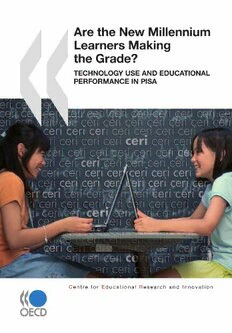
Educational Research and Innovation Are the New Millennium Learners Making the Grade? : Technology Use and Educational Performance in PISA 2006 PDF
215 Pages·2010·5.398 MB·English
Most books are stored in the elastic cloud where traffic is expensive. For this reason, we have a limit on daily download.
Preview Educational Research and Innovation Are the New Millennium Learners Making the Grade? : Technology Use and Educational Performance in PISA 2006
Description:
Using data from PISA 2006, this book analyzes to what extent investments in technology enhance educational outcomes. One of the most striking findings of this study is that the digital divide in education goes beyond the issue of access to technology. A new second form of digital divide has been identified: the one existing between those who have the right competencies to benefit from computer use, and those who do not. These competencies and skills are closely linked to the economic, cultural and social capital of the student. This finding has important implications for policy and practice. Governments should make an effort to clearly convey the message that computer use matters for the education of young people and do their best to engage teachers and schools in raising the frequency of computer use to a level that becomes relevant. If schools and teachers are really committed to the development of 21st century competencies, such an increase will happen naturally. And only in these circumstances will clear correlations between technology use and educational performance emerge. Table of Content : - Foreword - Executive summary - Introduction - The policy debate about technology in education - Students access to information and communication technologies - Students use of information and communication technologies and the role of confidence - Students use of information and communication technologies and performance in PISA 2006 - Conclusions and policy recommendations - Annex A. Supplementary tables - Annex B. Methodological approach to categorising student profiles - Annex C. Econometric model and methodological approach to the analysis of the effects of technology on student performance - Annex D. PISA 2006 ICT familiarity questionnaire
See more
The list of books you might like
Most books are stored in the elastic cloud where traffic is expensive. For this reason, we have a limit on daily download.
